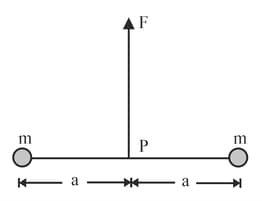G L Mittal and TARUN MITTAL Solutions for Chapter: Force : Newton's Laws of Motion, Exercise 3: FOR DIFFERENT COMPETITIVE EXAMINATIONS
G L Mittal Physics Solutions for Exercise - G L Mittal and TARUN MITTAL Solutions for Chapter: Force : Newton's Laws of Motion, Exercise 3: FOR DIFFERENT COMPETITIVE EXAMINATIONS
Attempt the practice questions on Chapter 9: Force : Newton's Laws of Motion, Exercise 3: FOR DIFFERENT COMPETITIVE EXAMINATIONS with hints and solutions to strengthen your understanding. ISC Physics Class XI Part 1 solutions are prepared by Experienced Embibe Experts.
Questions from G L Mittal and TARUN MITTAL Solutions for Chapter: Force : Newton's Laws of Motion, Exercise 3: FOR DIFFERENT COMPETITIVE EXAMINATIONS with Hints & Solutions
A boy sitting on the topmost berth in the compartment of a train which is just going to stop on a railway station, drops an apple at the open hand of his brother sitting vertically below his hand at a distance of about . The apple will fall:
Two particles of mass each are tied at the ends of a light string of length . The whole system is kept on a frictionless horizontal surface with the string held tight so that each mass is at a distance from the centre (as shown in the figure). Now the mid point of the string is pulled vertically upwards with a small but constant force . As a result, the particles move towards each other on the surface. The magnitude of acceleration, when the separation between them is is:

Two balls, having linear momenta and , undergo a collision in free space. There is no external force acting on the balls. Let and be their final momenta. The following option (s) is (are) not allowed for any non-zero value of and :
An isolated particle of mass is moving in a horizontal plane along the , at a certain height above the ground. It suddenly explodes into two fragments of masses and . An instant later, the smaller fragment is at . The larger fragment at this instant is at:
A balloon of mass is descending down with an acceleration . How much mass should be removed from it so that it starts moving up with an acceleration ?
The force acting on a particle of mass is indicated by the force-time graph shown adjoining. The change in momentum of the particle over the time interval from is:

A particle moves in the x-y plane under the action of a force such that the value of its linear momentum at any time is . The angle between and at a given time will be:
Two particles of masses and in projectile motion have velocities and respectively at time . They collide at time . Their velocities become and at time , while still moving in the air. The value of is:
